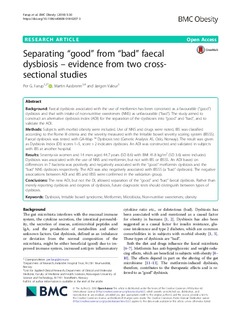| dc.contributor.author | Farup, Per Grønaas | |
| dc.contributor.author | Aasbrenn, Martin | |
| dc.contributor.author | Valeur, Jørgen | |
| dc.date.accessioned | 2019-09-06T07:38:06Z | |
| dc.date.available | 2019-09-06T07:38:06Z | |
| dc.date.created | 2018-12-03T18:51:32Z | |
| dc.date.issued | 2018 | |
| dc.identifier.citation | BMC Obesity. 2018, 5 1-10. | nb_NO |
| dc.identifier.issn | 2052-9538 | |
| dc.identifier.uri | http://hdl.handle.net/11250/2612858 | |
| dc.description.abstract | Background
Faecal dysbiosis associated with the use of metformin has been conceived as a favourable (“good”) dysbiosis and that with intake of non-nutritive sweeteners (NNS) as unfavourable (“bad”). The study aimed to construct an alternative dysbiosis index (ADI) for the separation of the dysbioses into “good” and “bad”, and to validate the ADI.
Methods
Subjects with morbid obesity were included. Use of NNS and drugs were noted, IBS was classified according to the Rome III criteria and the severity measured with the Irritable bowel severity scoring system (IBSSS). Faecal dysbiosis was tested with GA-Map ™ Dysbiosis test (Genetic Analysis AS, Oslo, Norway). The result was given as Dysbiosis Index (DI) scores 1–5, score > 2 indicates dysbiosis. An ADI was constructed and validated in subjects with IBS at another hospital.
Results
Seventy-six women and 14 men aged 44.7 years (SD 8.6) with BMI 41.8 kg/m2 (SD 3.6) were included. Dysbiosis was associated with the use of NNS and metformin, but not with IBS or IBSSS. An ADI based on differences in 7 bacteria was positively and negatively associated with the “good” metformin dysbiosis and the “bad” NNS dysbiosis respectively. The ADI was also negatively associated with IBSSS (a “bad” dysbiosis). The negative associations between ADI and IBS and IBSS were confirmed in the validation group.
Conclusions
The new ADI, but not the DI, allowed separation of the “good” and “bad” faecal dysbiosis. Rather than merely reporting dysbiosis and degrees of dysbiosis, future diagnostic tests should distinguish between types of dysbiosis. | nb_NO |
| dc.language.iso | eng | nb_NO |
| dc.publisher | BMC (part of Springer Nature) | nb_NO |
| dc.rights | Navngivelse 4.0 Internasjonal | * |
| dc.rights.uri | http://creativecommons.org/licenses/by/4.0/deed.no | * |
| dc.title | Separating “good” from “bad” faecal dysbiosis – evidence from two cross-sectional studies | nb_NO |
| dc.type | Journal article | nb_NO |
| dc.type | Peer reviewed | nb_NO |
| dc.description.version | publishedVersion | nb_NO |
| dc.source.pagenumber | 1-10 | nb_NO |
| dc.source.volume | 5 | nb_NO |
| dc.source.journal | BMC Obesity | nb_NO |
| dc.identifier.doi | 10.1186/s40608-018-0207-3 | |
| dc.identifier.cristin | 1638643 | |
| dc.description.localcode | © The Author(s). 2018 Open Access This article is distributed under the terms of the Creative Commons Attribution 4.0 International License (http://creativecommons.org/licenses/by/4.0/) | nb_NO |
| cristin.unitcode | 194,65,15,0 | |
| cristin.unitname | Institutt for klinisk og molekylær medisin | |
| cristin.ispublished | true | |
| cristin.fulltext | original | |
| cristin.qualitycode | 1 | |

